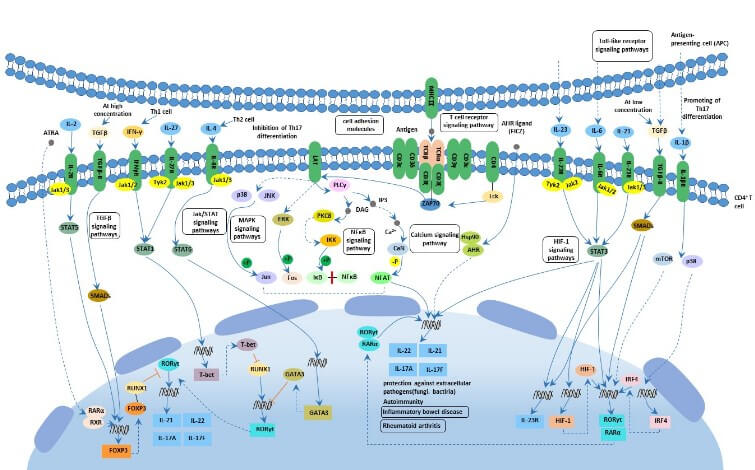Th17 Cell Differentiation signaling pathway
Based on Luminex technology platform, Creative Proteomics provides analysis services for key targets of Th17 cell differentiation signaling pathway.
Th17 cells are a subgroup of cells that secrete IL-17 (ie IL-17A) discovered in 2003, and together with Th1, Th2, and Tregs, they constitute four subgroups of CD4+ T cells. Th17 cells are differentiated from Th0 cells under the stimulation of IL-6 and TGF-β. It plays a key role in immune regulation, host defense and autoimmune diseases.
The effector molecules produced by Th17 cells mainly include IL-17A and IL-17F. IL-17A and IL-17F have similar functions and can act on a variety of cell types to induce the production of cytokines, chemokines and metalloproteinases. In addition, Th17 cells also secrete IL-21 and IL-22. IL-21 regulates the differentiation of Th17 in an autocrine form. IL-22 exerts its effects through its receptor.

The main function of Th17 cells is to promote the mobilization, recruitment and activation of neutrophils, and to mediate pro-inflammatory reactions. It is closely related to the occurrence of autoimmune diseases, infectious diseases and tumors.
The positive regulators of this pathway include: transforming growth factor β (TGF-β), IL-6, IL-9, IL-1, IL-23, IL-21, IRF4, STAT3, RORα and RORγt. Negative regulators include: IL-2, IL-4, IL-27, STAT1, STAT5, suppressor of cytokine signaling 3 (Socs3), Ets-1 and interferon gamma (IFN-γ).
Th17 cell differentiation mainly includes three stages: induction, expansion and stabilization. At each stage, the differentiation of Th17 cells is finely and complicatedly regulated by a variety of cytokines and signaling molecules.
- In the induction phase, TGF-β and IL-6 are the main inducing factors to promote Th17 cell differentiation. Too high concentration of TGF-β will induce the expression of Foxp3 and antagonize the pro-differentiation effect of transcription factor RORγt, thereby inhibiting the differentiation of Th17 cells.
- In the expansion stage, the cytokine IL-21 promotes or maintains the differentiation of Th17 cells through the autocrine method dependent on STAT3.
- The stable phase is mainly maintained by IL-23. When IL-23 binds to its receptor, it can activate the JAK-STAT signaling pathway, which causes the phosphorylation of Jak2 and Tyk2, which in turn promotes the phosphorylation of STAT1, STAT3, STAT4 and STAT5.
Our detectable targets:
| IL-27 | IL-2 | IL-23 | IL-6 | TGFB | IL-15 |
| STATS | STAT1 | STATG | JUS | AHK | IKK |
| Tyk2 | Tyk1 | STAT3 | mTCR | p52 | IRF4 |
| IRF6 | HIF-1 | IL-22 | T-bet | IL-22 | IL-21 |
| GATA3 | FOXP3 | RXR | p38 | SMADS |
Technology platform
We provide Luminex technology for Th17 cell signaling pathway analysis.
Luminex technology is a multifunctional liquid phase analysis platform developed on the basis of colored microspheres, laser technology, applied fluidics and high-speed digital signal processing technology. The core is to encode polypropylene microspheres or magnetic microspheres with fluorescent dyes. By adjusting the different ratios of the two fluorescent dyes, up to 100 microspheres with different fluorescence spectra can be obtained. Each kind of microspheres is covalently cross-linked. Capture antibodies against specific antigens.
Th17 cells are differentiated from Tho cells under the stimulation of IL-6 and TGF-β. It plays a key role in immune regulation, host defense and autoimmune diseases.
In addition to Luminex Multiplex Assay, Enzyme-linked immunosorbent assay (ELISA), Flow cytometry (FACS analysis) technology can also be provided to meet other customer needs.
Advantages of Th17 cell signaling pathway detection:
- High flexibility: specific probes, antigens or antibodies can be connected to the microspheres to meet the needs of different customers.
- High sensitivity: the detection limit can reach 0.01pg/ml.
- Good repeatability: similar homogeneous reaction mode, each indicator has 1000-5000 reaction units, and the median value of 100 analysis is taken.

Application of our service:
- To study the effect of each virus on Th17 cell differentiation signaling pathway
- To study the regulation mechanism of Th17 cell differentiation signal pathway in disease
- To study the effects of drugs or therapies on Th17 cell differentiation signaling pathways
Creative Proteomics has developed a signal pathway target detection platform. We are not limited to providing Th17 cell differentiation signal path detection services, but can also provide other signal path detection services. If you want to detect other targets, please contact us and we will customize the service for you. Look forward to working with you.
References:
- Mandy J.McGeachy, Daniel J.Cua1, et al. Th17 Cell Differentiation: The Long and Winding Road. Immunity, 2018, 28(4): 445-453.
- Dong, C. Genetic controls of Th17 cell differentiation and plasticity. Exp Mol Med, 2019, 43: 1–6.

